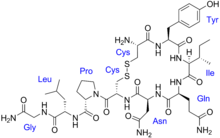Oksitosin

| |

| |
Oksitosin
| |
| Ngaran sistimatik (IUPAC) | |
| 1-({(4R,7S,10S,13S,16S,19R)-19-amino-7-(2-amino-2-oxoethyl)-10-(3-amino-3-oxopropyl)-16-(4-hydroxybenzyl)-13-[(1S)-1-methylpropyl]-6,9,12,15,18-pentaoxo-1,2-dithia-5,8,11,14,17-pentaazacycloicosan-4-yl}carbonyl)-L-prolyl-L-leucylglycinamide | |
| Identifiers | |
| Nomer CAS | |
| Sandi ATC | ? |
| PubChem | |
| DrugBank | |
| ChemSpider | |
| Data kimia | |
| Rumus | C43H66N12O12S2 |
| Mass. mol. | 1007.19 g/mol |
| SMILES | & |
| Data farmakokinetik | |
| Bioavailabilitas | ? |
| Ikatan protein | 30% |
| Metabolisme | liver and other oxytocinases |
| Waktu paruh | 1–6 min (IV) ~2 h (intranasal)[1][2] |
| Eksresi | Biliary and kidney |
| Therapeutic considerations | |
| Kat. kehamilan |
? |
| Legal status | |
| Jalur | ? |
Oksitosin (Oxt) mangrupa hormon péptida sarta neuropéptida. Oksitosin galibna dijieun di hipotalamus sarta dikaluarkeun ku pituitari posterior,[3] anu boga peran dina beungkeutan sosial, réproduksi séksual, ngalahirkeun, sarta mangsa sanggeus ngalahirkeun.[4] Oksitosin dileupaskeun kana aliran getih salaku hormon ngajawab babatekna sérviks jeung rahim nalika ngajuru atawa rangsangan kana puting nalika nyusuan.[5] Oksitosin kapanggih ku Henry Dale taun 1906,[6] anapon struktur molekulna kapanggih taun 1952.[7] Oksitosin ogé dipaké pikeun natambaan/ngalancarkeun anu ngajuru.[8][9][10]
Biokimia
éditÉstrogén geus kanyahoan bisa ngaronjatkeun sékrési oksitosin sarta ngaronjatkeun éksprési reséptorna,reséptor oksitosin, dina uteuk.[12] Di awéwé, sadosis éstradiol geus cukup pikeun ngundakkeun kadar oksitosin dina sirkulasi.[13]
Rujukan
édit- ↑ "Intranasal oxytocin administration is reflected in human saliva". Psychoneuroendocrinology 37 (9): 1582–6. 2012. doi:10.1016/j.psyneuen.2012.02.014. PMID 22436536.
- ↑ "Salivary levels of oxytocin remain elevated for more than two hours after intranasal oxytocin administration". Neuro Endocrinology Letters 33 (1): 21–5. 2012. PMID 22467107.
- ↑ Gray's Anatomy: The Anatomical Basis of Clinical Practice (41 ed.). Elsevier Health Sciences. 2015. p. 358. ISBN 978-0-7020-6851-5.
- ↑ "Nonsocial functions of hypothalamic oxytocin". ISRN Neuroscience 2013: 179272. 2013. doi:10.1155/2013/179272. PMC 4045544. PMID 24967304. http://www.pubmedcentral.nih.gov/articlerender.fcgi?tool=pmcentrez&artid=4045544.
- ↑ Chiras DD (2012). Human Biology (7th ed.). Sudbury, MA: Jones & Bartlett Learning. p. 262. ISBN 978-0-7637-8345-7.
- ↑ Dale, H. H (1906). "On some physiological actions of ergot". The Journal of Physiology 34 (3): 163–206. doi:10.1113/jphysiol.1906.sp001148. PMC 1465771. PMID 16992821. http://www.pubmedcentral.nih.gov/articlerender.fcgi?tool=pmcentrez&artid=1465771.
- ↑ Corey EJ (2012). "Oxytocin". Molecules and Medicine. John Wiley & Sons. ISBN 978-1-118-36173-3.
- ↑ "Oxytocin: Summary". IUPHAR/BPS guide to pharmacology. International Union of Basic and Clinical Pharmacology. Diakses tanggal 14 December 2016.
Endogenous oxytocin is a hormone and neuropeptide, which plays a role in social bonding, sexual reproduction and is required during and after childbirth. Purified oxytocin is used clinically.
Archived 25 Oktober 2020 di Wayback Machine - ↑ "Oxytocin". The American Society of Health-System Pharmacists. Diakses tanggal 1 June 2015.
- ↑ The Oxford Handbook of Prosocial Behavior. Oxford University Press. 2015. p. 354. ISBN 978-0-19-539981-3.
- ↑ "Human PubMed Reference:".
- ↑ Goldstein I, Meston CM, Davis S, Traish A (17 November 2005). Women's Sexual Function and Dysfunction: Study, Diagnosis and Treatment. CRC Press. pp. 205–. ISBN 978-1-84214-263-9.
- ↑ "Oxytocin and Estrogen Receptor β in the Brain: An Overview". Frontiers in Endocrinology 6: 160. 2015. doi:10.3389/fendo.2015.00160. PMC 4606117. PMID 26528239. http://www.pubmedcentral.nih.gov/articlerender.fcgi?tool=pmcentrez&artid=4606117.
Bacaeun
édit- Caldwell HK, Young WS (2006). "Oxytocin and Vasopressin: Genetics and Behavioral Implications" (PDF). Di Abel L, Lim R. Handbook of neurochemistry and molecular neurobiology. Berlin: Springer. pp. 573–607. ISBN 978-0-387-30348-2.
- Fillod O (2014), "Oxytocin as proximal cause of 'maternal instinct': weak science, post-feminism, and the hormones of mystique", di Schmitz S, Höppner G, Gendered neurocultures: feminist and queer perspectives on current brain discourses, challenge GENDER, 2, Wien: Zaglossus, ISBN 9783902902122.
- Yong E (13 November 2015), "The weak science behind the wrongly named moral molecule", The Atlantic.